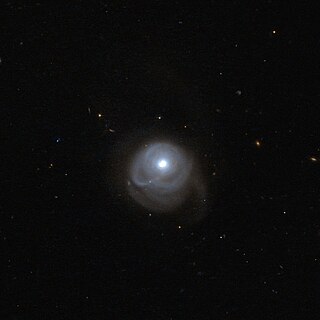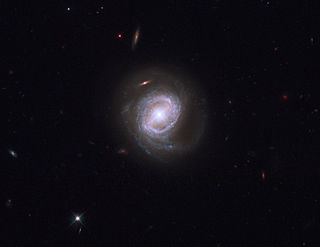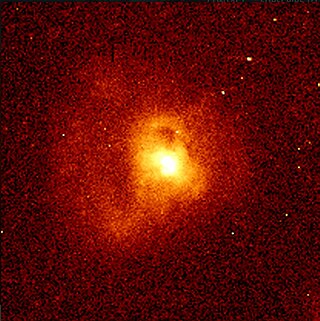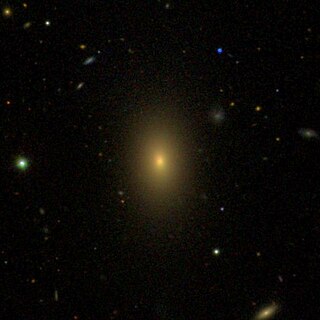Luminous infrared galaxies or LIRGs are galaxies with luminosities, the measurement of brightness, above 1011 L☉. They are also referred to as submillimeter galaxies (SMGs) through their normal method of detection. LIRGs are more abundant than starburst galaxies, Seyfert galaxies and quasi-stellar objects at comparable luminosity. Infrared galaxies emit more energy in the infrared than at all other wavelengths combined. A LIRG's luminosity is 100 billion times that of the Sun.

APM 08279+5255 is a very distant, broad absorption line quasar located in the constellation Lynx. It is magnified and split into multiple images by the gravitational lensing effect of a foreground galaxy through which its light passes. It appears to be a giant elliptical galaxy with a supermassive black hole and associated accretion disk. It possesses large regions of hot dust and molecular gas, as well as regions with starburst activity.

Markarian 231 is a Type-1 Seyfert galaxy that was discovered in 1969 as part of a search of galaxies with strong ultraviolet radiation. It contains the nearest known quasar. Markarian 231 is located about 581 million light years away from Earth, in the constellation of Ursa Major.

The Teacup galaxy, also known as the Teacup AGN or SDSS J1430+1339 is a low redshift type 2 quasar, showing an extended loop of ionized gas resembling a handle of a teacup, which was discovered by volunteers of the Galaxy Zoo project and labeled as a Voorwerpje.

Markarian 273 is a galaxy merger located in the constellation Ursa Major. It is located at a distance of about 500 million light years from Earth, which, given its apparent dimensions, means that Markarian 273 is about 130,000 light years across. It is an ultraluminous infrared galaxy and a Seyfert galaxy.

UGC 5101 is a galaxy merger located in the constellation Ursa Major. It is located at a distance of about 530 million light years from Earth. It is an ultraluminous infrared galaxy. The total infrared luminosity of the galaxy is estimated to be 1011.95 L☉ and the galaxy has a total star formation rate of 105 M☉ per year.

An extended emission-line region (EELR) is a giant interstellar cloud ionized by the radiation of an active galactic nucleus (AGN) inside a galaxy or photons produced by the shocks associated with the radio jets. An EELR can appear as a resolved cloud in relative nearby galaxies and as narrow emission lines in more distant galaxies.

IRAS 05189-2524 is a galaxy merger located in the constellation Lepus. It is located 603 million light-years away from the Solar System and has an approximate diameter of 75,000 light-years.

Markarian 817 is a barred spiral galaxy located in the constellation Draco. It is located 456 million light-years from Earth, which, given its apparent dimensions, means that Markarian 817 is about 80,000 light-years across. It is a Seyfert galaxy.

IRAS F11119+3257 or simply as F11119+3257, is a galaxy located in constellation Ursa Major. With a redshift of 0.187580, it has a light travel time distance of 2.5 billion light-years and is considered an ultraluminous infrared galaxy (ULIRG).

IRAS 09104+4109 is a galaxy located in the constellation Lynx. With a redshift of 0.440797, the light travel time for this galaxy, corresponds to 4.8 billion light-years from Earth. It is the brightest cluster galaxy in MACS J0913.7+4056 galaxy cluster and classified as a hyperluminous infrared galaxy.

IRAS 13218+0552 known as SFRS 263, is a galaxy merger located in the Virgo constellation. Its redshift is 0.202806, putting the object at 2.6 billion light-years away from Earth. It is a Seyfert galaxy and a luminous infrared galaxy.

PKS 1345+125 known as PKS 1345+12 and 4C +12.50, is an ultraluminous infrared galaxy (ULIG) with an active galactic nucleus, located in the constellation Boötes. With a redshift of 0.121740, the galaxy is located 1.7 billion light-years from Earth.

NGC 4325 is an elliptical galaxy located about 330 million light-years away in the constellation Virgo. It was discovered by astronomer Heinrich d'Arrest on April 15, 1865, who described it as "vF, vS, iR, nf of 2". Despite being listed in the Virgo Cluster catalog as VCC 616, it is not a member of the Virgo Cluster but instead a background galaxy.

SDSS J135646.10+102609.0 known as SDSS J1356+1026 and J1356+1026, is a low redshift quasar and galaxy merger located in the constellation of Boötes. It is located 1.85 billion light years from Earth. It is an ultraluminous inflared galaxy. It is considered radio-quiet with an unresolved radio source.

Markarian 463 known as UGC 8850, is a galaxy merger located in the constellation Boötes. It is located 706 million light years from Earth. It is classified a double nucleus Seyfert galaxy.

ESO 286-19 known as IRAS 20551-4250, is a galaxy merger located in the constellation of Microscopium. It is located 609 million light years away from Earth. It is an ultraluminous infrared galaxy.

IRAS 10565+2448 known as IRAS F10565+2448, is a galaxy merger located in the constellation of Leo. It is located at a distance of 625 million light years from Earth. It is classified as an ultraluminous infrared galaxy with an infrared luminosity of 1.2 x 1012 LΘ. It has a star formation rate of 131.8 MΘ yr−1.

IRAS 07598+6508 known as IRAS F07599+6508, is a quasar located in the constellation of Camelopardalis. It is located 2.37 billion light years from Earth and is classified as both an ultraluminous infrared galaxy and a Seyfert galaxy.

IRAS 01003-2238 also known as IRAS F01004-2237 or simply F01004-2237, is a galaxy located in the constellation of Cetus. It is located 1.65 billion light years away from Earth and is a Seyfert galaxy and an ultraluminous infrared galaxy. IRAS 01003-2238 is also classified as a Wolf-Rayet galaxy, making the object one of the most distant known.



















